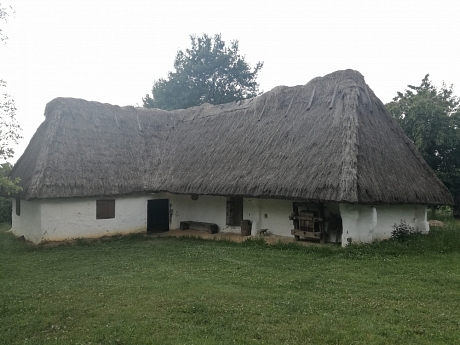How does thatching straw become roofing?
How does thatching straw become roofing?
2019 Summer University of Folk Architecture in Oszkó
Viktória Kmellár
The Summer University of Folk Architecture started on 14 July 2019. The participants arrived at the venue on a Sunday, and the week was started by István Kovács, the president of the Hegypásztor Circle, by presenting the architectural and ethnobotanical features, and operations of the Szőlőhegy (vineyard) in Oszkó, and he also gave an account of the history of the Gombás Cellar in detail.
After exploring the area, the participants also got to know each other during the dinner they had together in the evening. The actual work began on Monday morning. Before the demolition of the worn-out roof of the Gombás Cellar, the participants were able to get into the secrets of making the building material. Before the start of the workshop that consisted of threshing, combing and doubling the sheaves of the raw material, Ádám Bihari presented the thatching techniques, and the rye straw itself and its properties to the participants. András Szecsődi, Young Master of Folk Art, got the participants acquainted with the process of doubling the sheaves. During the afternoon, removal of the worn-out thatching began, to which one half of the team joined while the rest of the group continued to produce the building material for the roof. The day was finished with dr. Ibolya Bereczki’s presentation, who outlined the lifework of Tibor Sabján, including his efforts for folk architecture.
The work continued in two groups on Tuesday, one group went on doing the threshing, combing and doubling the sheaves, while the other continued to take part in the demolition. After the worn out thatching was removed, the roof battens were repaired. After the completion of the works in the evening, Miklós Buzás, the chief architect of Skanzen gave a presentation on mud architecture and gave general information about roofing, and then he spoke about Tibor Sabján’s research in this field.
The tying of the already doubled sheaves to the roof could start on Wednesday, and some members of the group helped András Szecsődi to harvest rye straw in the fields in the fields of Győrvár and Hegyhátszentpéter. Thus, the participants could not only learn about the processes of tying the already completed building material to the roof, but also through the harvesting of the rye sown earlier, the whole process could be overviewed. The theoretical lecture in the evening was given by Miklós Buzás, when the participants could get acquainted with the history of ovens from the open fireplace to the kitchen with a climbing chimney through the work of Tibor Sabján.
The participants took part in the work alternately, so everyone could try and learn the different work phases of the roofing works: watering the sheaves before tying them to the roof to make it easier to form a rope, tying the bottom skirt rows and then the head rows, as well as throwing the sheaves onto the roof. In addition to Ádám Bihari, István Tóth, an employee of the Hegypásztor Circle, instructed us how to acquire the technique of tying the sheaves to the roof.
The participants could hear about the survival and utilisation of folk architecture techniques not only during the days in the practices and conversations, but also during the evening lecture by András Krizsán DLA, the president of the Association of Hungarian Architects.
In addition to the roofing work, the participants were introduced to the traditional mud plastering of log-walled buildings on Friday morning. The workshop was led by János Gáspár, a master builder of mud walls. After that, the formation of stepped edges at the Gombás Cellar began, and the tying the sheaves to the roof also continued.
The week ended with the President of the Hegypásztor Circle, István Kovács’s presentation on the Artistic project, the central theme of which was local economic development based on intangible cultural heritage. At the present stage of the project, the focus is on the utilisation of folk architectural heritage, an approach that also fit well with the objectives of the Summer University. The experience of the work done during the week was discussed by the participants after the presentation.
The workflows presented during the programme allowed participants to learn the secrets of making sheaves. From an agricultural waste of harvested and threshed rye called straw, a building material suitable for roofing was created with the hands of the participants by combing and doubling the sheaves. The participants acquired practical knowledge in the training that can be used later in the future.
Those who took part in the Summer University of Folk Architecture were Attila Bődi, Borbála Labancz, Attila Mészáros, Dorottya Mráz, Andrea Nagy, Balázsné Pintér, Attila Rácz and Attila Szőke; on behalf of Hagyományos Házépítő Kft. Ádám Bihari, dr. Zoltán Bihari, Kinga Gacsályi, Dániel Kondás, István Kovács, Ana Pato (Portugal), Martin Takács, István Tóth ‘Gömbölő’ and Tamás Varga; and on behalf of MTKI dr. Ibolya Bereczki, Noémi Fancsalszki, Viktória Kmellár and Szilvia Beatrix Prikler.
We would like to thank all the participants for their active involvement, the theoretical and practical work of our instructors and the contribution of the staff of the Hegypásztor Circle in Oszkó.
The staff of the Directorate of Hungarian Country House Museums continuously documented the events of the week. The photos and videos taken during the week of the Summer University of Folk Architecture, as well as the broadcasts of the works, are available on the Facebook page at the following link: https://www.facebook.com/MTKI.Skanzen/
| |
















